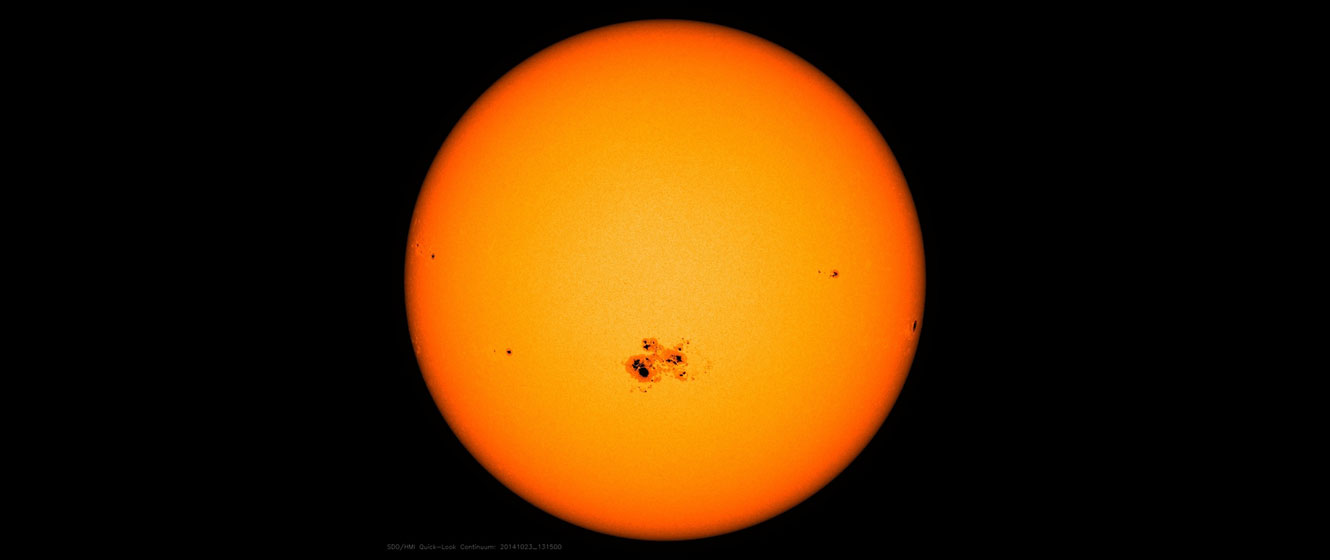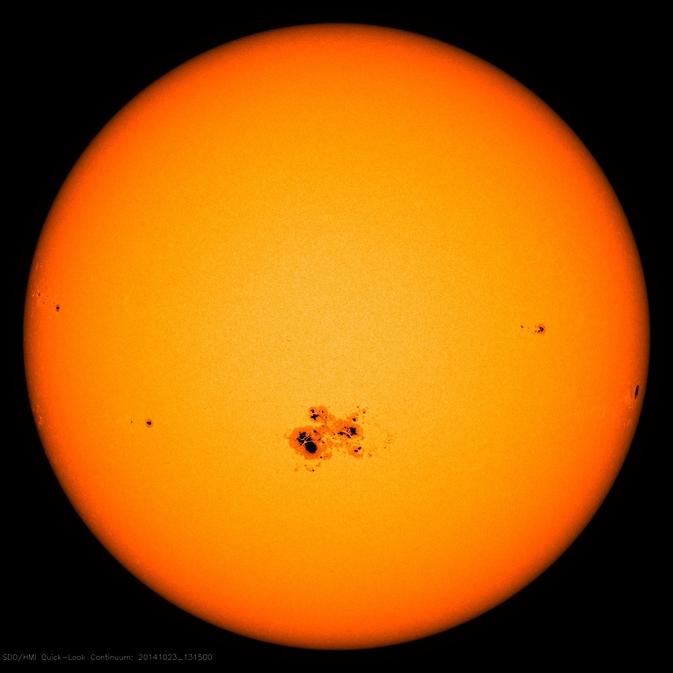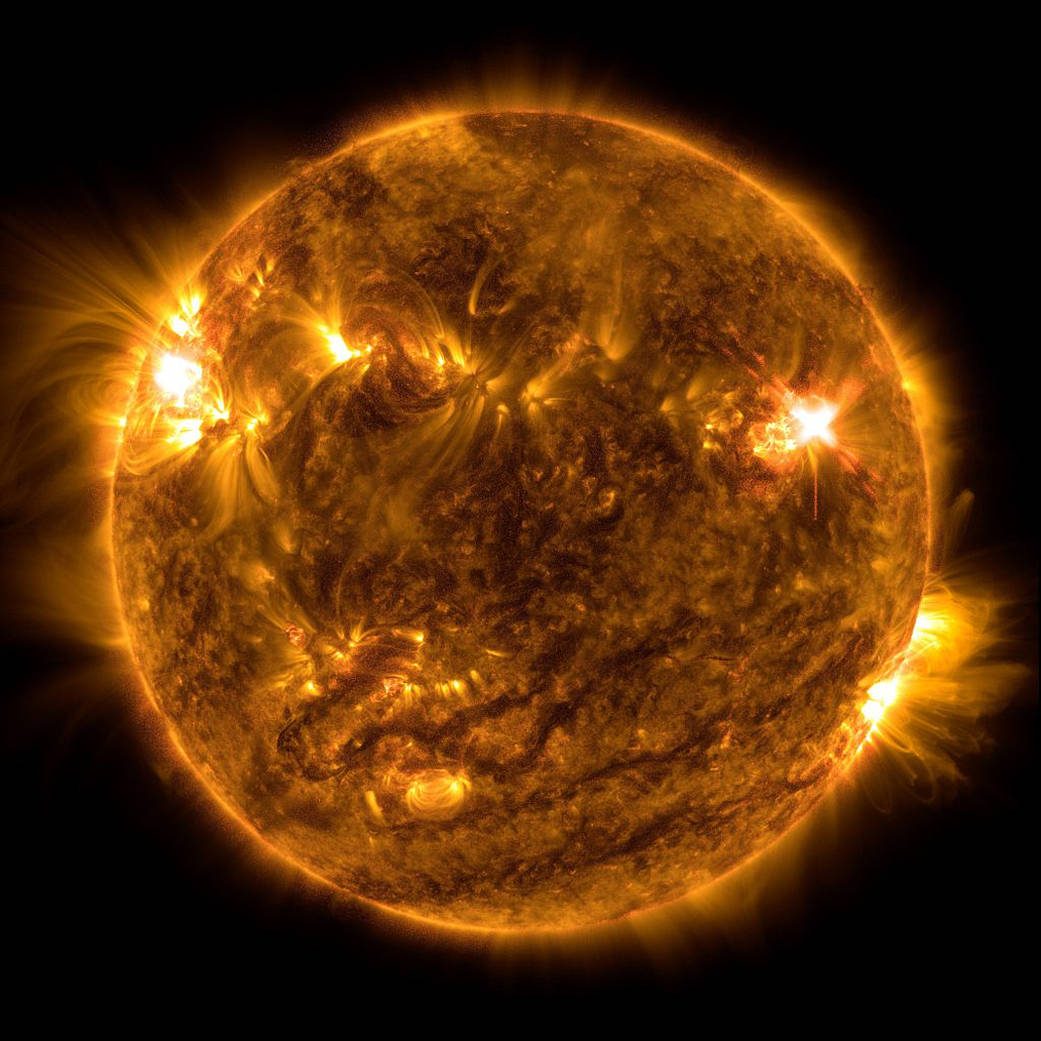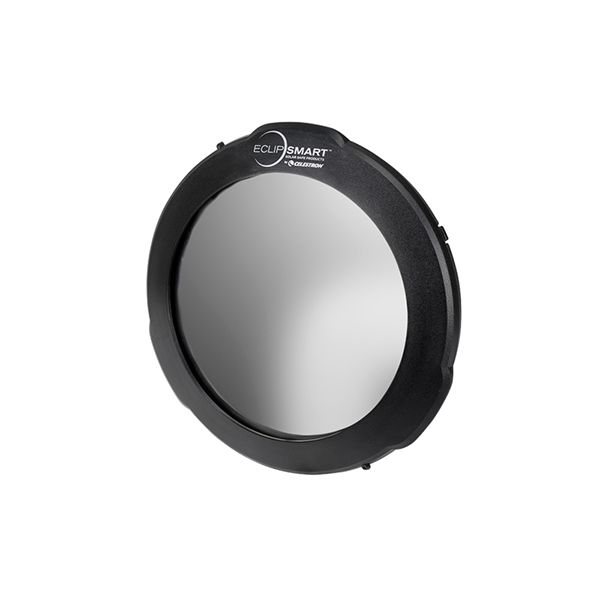
At some time or another, you’ve probably seen photos of the Sun with dark spots on its surface. These markings, known as sunspots, have been studied for hundreds of years, but what are they? What causes them? And is there a way to safely see them for yourself?
What Are Sunspots?
The Sun, of course, is our nearest star in space. A star is primarily composed of helium and hydrogen and generates heat and light through the process of nuclear fusion at its core.
The Sun is a fairly typical star, roughly 4.6 billion years old, and it generates a staggering amount of energy; in just one second, it produces roughly a million times more energy than the population of the Earth consumes in a year.
Given this fact, it’s perhaps little wonder that despite being 93 million miles (150 million kilometers) away, it remains bright enough to blind and hot enough to burn.
So just how hot is it? You might think it’s hot in the summer, but that’s nothing compared to the Sun. With an average surface temperature of 10,000°F (5,500°C), it’s hot enough to melt diamond (and then some!), but even the Sun has its cooler regions.
Those regions are the sunspots. Their temperature ranges from between 5,400°F and 8,000°F (3,000°C to 4,500°C) and since they are cooler, they produce far less light. Consequently, they appear dark against the background surface of the Sun.

Image Credit: NASA/SDO
What Causes Sunspots?
Besides generating an incredible amount of energy, the Sun also produces an intense magnetic field, and it’s this field that’s responsible for producing the sunspots.
Here’s how it works: With the Sun being a massive sphere of dense gas, its surface moves in a fluid-like motion, with different areas of its surface rotating at different speeds. The speed of rotation varies by latitude, with gasses at the equator moving fastest and the speed decreasing the closer you get to the north or south poles.
For example, the equator of the Sun completes one rotation in about 24-25 days, while the poles take about 10 days longer.
These different rotation speeds cause the magnetic field to become twisted and distorted. A sunspot then forms where the magnetic field becomes concentrated and tangled in a specific area and breaks through the surface of the Sun.
These aren’t minor disturbances, either. Sunspots often form in groups, with each sunspot usually somewhere between 10,000 and 50,000 miles (16,000 to 80,000 kilometers) in diameter. In comparison, the Earth is just under 8,000 miles (13,000 kilometers) in diameter, so the vast majority are larger than the Earth.
(The largest sunspot on record occurred in 1947 and was thought to be about 187,000 miles (300,000 kilometers) in diameter. That’s large enough to swallow two Jupiters!)
Sunspots & Flares: Solar Sisters
The same process that gives rise to sunspots can also have consequences for the Earth. Where the magnetic fields twist and tangle over the sunspots, they can also cause explosions of energy to erupt from the Sun.
Called a solar flare, this energy can hit the Earth and cause disturbances in our own magnetic field. As this energy is dispersed by the field, it collides with the particles of gas in our atmosphere, and observers on Earth see aurorae in the skies above.
However, there are other, potentially more dangerous consequences. Since this energy charges electrons in the Earth’s atmosphere, it can also cause disruption to radio signals, disrupt satellite communications, and even cause fluctuations in power grids on Earth.
One famous incident took place on March 13th, 1989, when a solar storm plunged the entire province of Quebec in Canada into darkness for 12 hours.

Image Credit: NASA/SDO
Sunspots and the Solar Cycle
Lastly, it’s worth knowing that the frequency of sunspot formation has close ties to the solar cycle. On average, this lasts 11 years, and while not fully understood, it is thought to be caused by fluctuations in the Sun’s magnetic field.
As the complexity of the field changes, so does the likelihood of sunspots forming. When the field is at its most complex, the rate of sunspot formation is at its highest. This part of the solar cycle is therefore called the solar maximum.
Conversely, at the opposite end of the scale, when the field is at its least complex, sunspots form far less frequently, and there may even be prolonged periods where there are no sunspots at all.
Solar minimum last occurred in December 2019, with the next maximum expected to begin in July 2025.
How to Safely Observe Sunspots
First of all, you should NEVER look directly at the Sun with your eyes or through unmodified binoculars or a telescope. There are, however, a number of ways you can safely look at the Sun if you want to observe sunspots.
Even though the telescope has only been around for a little over 400 years, the existence of sunspots has been known for thousands of years. That’s because on extremely foggy days, the light of the Sun is significantly reduced and it’s possible to see the Sun as a disc. Under these circumstances, a large enough sunspot can be visible to the naked eye as a tiny dark mark on the Sun.
Even so, it’s still not advisable to look at the Sun this way. As the mist moves, it can partially clear and the full strength of the sunlight can pierce its way through, damaging your eye in the process or even causing blindness.
Make Your Own Camera Obscura
A safer alternative is to create a camera obscura. This is easily done and can be a fun family activity for the weekend.
Essentially, you take a box and create one small hole and one large hole on one side. The smaller hole allows light to enter the box, while the larger hole is used to look through. Inside the box, at the opposite end of the holes, you glue a piece of white paper, which acts like a projector screen. The large hole will project the image of the Sun onto this paper.
With your back to the Sun, you aim the small hole toward the Sun and look through the large hole. It takes a little trial and error, but once aligned, you’ll be able to see the image of the Sun projected into the box.
You can find instructions on how to build a simple camera obscura here.
Buy a Specialized Scope, Adapt Your Own, or Use NASA’s
If you already own a telescope, you can modify it with a solar filter. These are like caps that fit over the aperture end of your telescope and will block the vast majority of sunlight. This allows you to safely observe the Sun without potentially damaging your eyes.
If you aren’t sure which solar filter will work best with your telescope, our experts have created a solar filter calculator for you to use.
(You may see some sites that sell solar filters that can be attached to an eyepiece, like a lunar filter for observing the Moon. Generally speaking, these should be avoided, as the glass is often of inferior quality and the magnified heat from the Sun can potentially cause it to break.)
If you’re serious about observing or imaging the Sun, you can always buy a solar telescope. Since these are specifically built for this purpose, you’ll find they cost more than a regular telescope, but the quality of the views is unparalleled.

Want to see more? You can also check out live images of the Sun from NASA’s Solar Dynamics Observatory (SDO) here.
What You Can Expect to See
Lastly, what will you see? If you’re using a camera obscura or a telescope at low power, you may just see the Sun with a number of dark markings on it. While you may not see much, you can still record the positions of the sunspots and then track their movements over the coming days and weeks.
However, use a higher magnification and you’ll see more detail. For example, when most amateur astronomers hear the words “umbra” and “penumbra,” they think of a lunar eclipse and the Earth’s shadow. However, both words also apply to sunspots.
The umbra of a sunspot is the central region where the spot appears blackest. Surrounding it is the penumbra, where the spot can appear mottled and show some texture.
The Sun, our star, is complex, with a number of interwoven processes having an impact on one another. The magnetic field itself may be invisible to the eye, but sunspots provide evidence of its existence and a fascinating way to study a star up close.

Learn More
Interested in learning more about the sun and our solar system? Not sure where to begin? Check out our Astronomy Hub!










